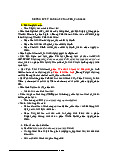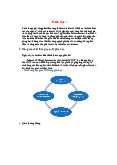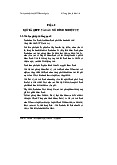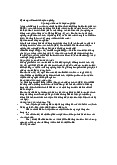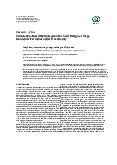







Preview text:
CHAPTER 4
1. Hiring workers who have criminal backgrounds without proper safeguards is considered ________.
A) improper screening B) negligent hiring
C) unreliable testing D) improper hiring
2. What is the primary goal of employee selection?
A) achieving person-job fit B) avoiding negligent hiring
C) developing a diverse workforce D) maintaining valid test scores
3. As a manager, what is the most important reason to select employees carefully?
A) meet industry and organizational standards
B) comply with federal and state labor laws
C) improve personal and organizational performance
D) establish a high-performing work system
4. Effective employee screening will most likely ________.
A) improve team management skills B) eliminate negative office politics C)
identify valid and reliable test procedures
D) reduce dysfunctional workplace behaviors
5. If a person scores a 70 on an intelligence test on one day and scores 110 when
retested on another day, you might conclude that this test is ________.
A) Valid B) reliable C) unreliable D) inconsistent
6. If a person scores a 78 on a test on one day and scores a 79 when retested on
another day, you would most likely conclude that the test is ________.
A) Valid B) invalid C) reliable D) unreliable
7. Which assessment method has a high development cost?
A) cognitive ability tests B) job knowledge tests
C) structured interviews D) integrity tests
8. What is the purpose of recruiting?
A) forecasting the supply of candidates B) developing an applicant pool C)
establishing a strategic plan D) developing qualifications inventories
9. What type of screening device is designed to measure attitudes regarding
tolerance of others who steal?
A) personality tests B) interest inventories
C) paper-and-pencil honesty tests D) graphology
10. All of the following are guidelines for conducting an effective interview EXCEPT ________.
A) asking the candidate questions that require yes or no answers
B) showing courtesy and friendliness towards the candidate
C) scheduling a private room for the interview
D) taking brief notes during the interview
11. Which of the following is the most likely outcome of using the same questions
with all candidates being interviewed?
A) revealing weaknesses B) managing time
C) expressing interest D) reducing bias
12. Which question below is an example of a background question?
A) "Can you provide an example of a time when you developed a highly effective ad campaign?"
B) "What experience and training have you had with drafting designs for commercial buildings?"
C) "What is the procedure you would follow when examining a patient complaining of chest pain?"
D) "What steps would you follow to conduct a brainstorming session with a group of employees on safety?" CHAPTER 5
1) ________ provides new employees with the basic background information
required to perform their jobs satisfactorily.
A) Employee recruitment B) Employee selection
C) Employee orientation D) Employee development
2) Which of the following would perform the initial orientation in most firms?
A) HR specialist B) mid-level manager
C) administrative assistant D) immediate supervisor
3) Maria was recently hired as an accountant with a large marketing firm. Today is
Maria's first day of work, and she will be attending an employee orientation
session. Which of the following is LEAST likely to be addressed during Maria's orientation?
A) employee benefits B) daily routine
C) safety measures D) sales methods
4) Which of the following is NOT one of the primary purposes of employee orientation?
A) The employee should become skilled with the firm's software.
B) The employee should understand the organization in a broad sense.
C) The employee should have a clear understanding of what is expected.
D) The employee should begin the process of learning the firm's preferences.
5) What is an alternative term for employee orientation?
A) development B) acculturation C) recruiting D) onboarding
6) Which of the following terms refers to the methods used to give new or present
employees the skills they need to perform their jobs?
A) orientation B) training C) development D) appraisal
7) Lucas, an HR manager, has been assigned the task of creating a training and
development program for his firm's employees. According to the ADDIE training
process model, what is the first step that Lucas should take?
A) assess the program's successes or failures B) design the program content C) conduct a needs analysis
D) train the targeted group of employees
8) Anna, an HR manager, wants to determine the training needs of a new employee
in the shipping department. Which of the following would most likely help Anna?
A) needs analysis B) task analysis
C) performance analysis D) training analysis
9) In the ADDIE training process model, which of the following occurs
immediately after a needs analysis has been conducted?
A) assessing the program's successes or failures
B) presenting the program to a test audience
C) designing the overall training program
D) training a targeted employee group
10) Which of the following would most likely occur during the implementation stage of a training program?
A) presenting the program to a small test audience
B) designing the program content for different learners
C) conducting a needs analysis of newly hired workers
D) providing on-the-job training to the targeted group of employees
11) A performance analysis is primarily used to assess the training needs of ________.
A) new employees B) prospective employees
C) current employees D) former employees
12) ________ is a method in which trainees learn on actual or simulated equipment
but are trained away from the job.
A) Vestibule training B) Apprenticeship training
C) Cubicle training D) Job instruction training
13) Which of the following training methods is experienced by almost all employees?
A) on-the-job training B) apprenticeship training
C) informal learning D) vestibule training
14) Any attempt to improve managerial performance by imparting knowledge,
changing attitudes, or increasing skills is called ________.
A) on-the-job training B) management by objectives
C) performance improvement programs D) management development
15) Which of the following is most likely NOT measured when evaluating a training program?
A) overall organizational productivity
B) participants' reactions to the program
C) what trainees learned from the program
D) achievement of training objectives CHAPTER 6
1. The process of evaluating an employee's current and/or past performance
relative to his or her performance standards is called ________.
A) Recruitment B) Employee selection
C) Performance appraisal D) Organizational development
2. Which of the following is NOT one of the recommended guidelines for setting effective employee goals?
A) assigning specific goals B) assigning measurable goals
C) administering consequences for poor performance
D) encouraging employees to participate in setting goals
3. SMART goals are best described as ________.
A) specific, measurable, attainable, relevant, and timely
B) strategic, moderate, achievable, relevant, and timely
C) specific, measurable, achievable, relevant, and tested
D) straightforward, meaningful, accessible, real, and tested
4. All of the following are reasons for appraising an employee's performance EXCEPT ________.
A) assisting with career planning
B) making decisions about promotions
C) creating an organizational strategy map
D) determining appropriate salary and bonuses
5. In most organizations, which of the following is primarily responsible for
appraising an employee's performance?
A) Employee's direct supervisor B) Human resources manager
C) EEO (Equal Employment Opportunity) representative D) Employee's peers
6. Which of the following is LEAST likely to be used by firms as an alternative
source of performance appraisal information?
A) Peers B) Rating committees C) The employee D) Outside experts
7. Setting work standards, assessing an employee's performance against those
standards, and providing employee feedback are the three steps of the ________.
A) orientation process B) development analysis
C) ratio analysis method D) performance appraisal cycle
8. In order to be the most effective, the performance management process should occur ________.
A) occasionally B) continuously C) periodically D) annually
9. Which performance appraisal technique lists traits and a range of performance for each?
A) alternation ranking B) graphic rating scale
C) paired comparison D) constant sum rating scale
10. Which performance appraisal method involves distinguishing between the
worst and best employees based on a trait or traits?
A) alternation ranking B) graphic rating scale
C) forced distribution D) constant sum rating scale
11. Suppose you have five employees to rate. You make a chart of all possible
pairs of employees for each trait being evaluated. Then, you indicate the better
employee of the pair for each pair. Finally, you add up the number of positives for
each employee. In this case, you have used the ________ method of performance appraisal.
A) graphic ranking scale B) alternation ranking
C) paired comparison D) forced distribution
12. Which performance appraisal tool is being used by a supervisor who places
predetermined percentages of rates into various performance categories?
A) graphic ranking scale B) alternation ranking
C) forced distribution D) paired comparison
13. Which of the following is one of the primary complaints regarding the use of
the forced distribution method for performance appraisals?
A) harm to employee morale B) high cost of administration
C) standardization of group sizes D) time consuming to administer
14. Which performance appraisal tool involves a supervisor maintaining a log of
positive and negative examples of a subordinate's work-related behavior?
A) alternation ranking B) constant sums rating
C) narrative forms D) critical incident
15. At M&M Enterprises, subordinates rate supervisor performances anonymously.
Which of the following refers to the process used at M&M?
A) downward feedback B) upward feedback
C) paired evaluation D) peer evaluation
16. Which of the following terms refers to a performance appraisal based on
surveys from peers, supervisors, subordinates, and customers?
A) committee rating B) team appraisal
C) upward feedback D) 360-degree feedback
